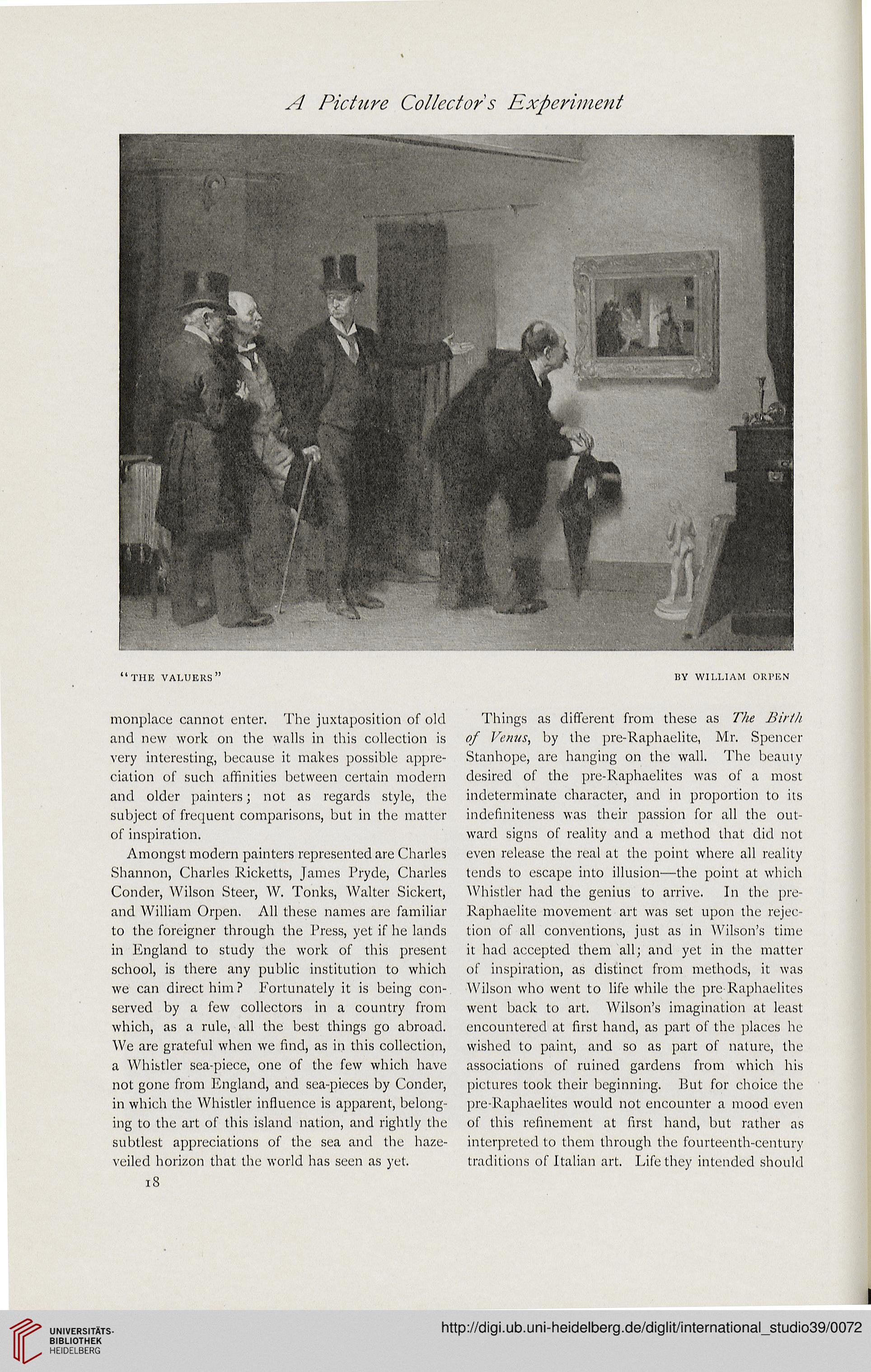A Picture Collector s Experiment
Till! VALUERS HY WILLIAM ORPBN
monplace cannot enter. The juxtaposition of old Things as different from these as The Birth
and new work on the walls in this collection is of Venus, by the pre-Raphaelite, Mr. Spencer
very interesting, because it makes possible appre- Stanhope, are hanging on the wall. The beamy
ciation of such affinities between certain modern desired of the pre-Raphaelites was of a most
and older painters; not as regards style, the indeterminate character, and in proportion to iis
subject of frequent comparisons, but in the matter indefiniteness was their passion for all the out-
of inspiration. ward signs of reality and a method that did not
Amongst modern painters represented are Charles even release the real at the point where all reality
Shannon, Charles Ricketts, James Pryde, Charles tends to escape into illusion—the point at which
Conder, Wilson Steer, W. Tonks, Walter Sickert, Whistler had the genius to arrive. In the pre-
and William Orpen. All these names are familiar Raphaelite movement art was set upon the rejec-
to the foreigner through the Press, yet if he lands tion of all conventions, just as in Wilson's time
in England to study the work of this present it had accepted them all; and yet in the matter
school, is there any public institution to which of inspiration, as distinct from methods, il was
we can direct him? Fortunately it is being con- Wilson who went to life while the pre-Raphaelites
served by a few collectors in a country from went back to art. Wilson's imagination at least
which, as a rule, all the best things go abroad, encountered at first hand, as part of the places he
We are grateful when we find, as in this collection, wished to paint, and so as part of nature, the
a Whistler sea-piece, one of the few which have associations of ruined gardens from which his
not gone from England, and sea-pieces by Conder, pictures took their beginning. But for choice the
in which the Whistler influence is apparent, belong- pre-Raphaelites would not encounter a mood even
ing to the art of this island nation, and rightly the of this refinement at first hand, but rather as
subtlest appreciations of the sea and the haze- interpreted to them through the fourteenth-century
veiled horizon that the world has seen as yet. traditions of Italian art. Life they intended should
18
Till! VALUERS HY WILLIAM ORPBN
monplace cannot enter. The juxtaposition of old Things as different from these as The Birth
and new work on the walls in this collection is of Venus, by the pre-Raphaelite, Mr. Spencer
very interesting, because it makes possible appre- Stanhope, are hanging on the wall. The beamy
ciation of such affinities between certain modern desired of the pre-Raphaelites was of a most
and older painters; not as regards style, the indeterminate character, and in proportion to iis
subject of frequent comparisons, but in the matter indefiniteness was their passion for all the out-
of inspiration. ward signs of reality and a method that did not
Amongst modern painters represented are Charles even release the real at the point where all reality
Shannon, Charles Ricketts, James Pryde, Charles tends to escape into illusion—the point at which
Conder, Wilson Steer, W. Tonks, Walter Sickert, Whistler had the genius to arrive. In the pre-
and William Orpen. All these names are familiar Raphaelite movement art was set upon the rejec-
to the foreigner through the Press, yet if he lands tion of all conventions, just as in Wilson's time
in England to study the work of this present it had accepted them all; and yet in the matter
school, is there any public institution to which of inspiration, as distinct from methods, il was
we can direct him? Fortunately it is being con- Wilson who went to life while the pre-Raphaelites
served by a few collectors in a country from went back to art. Wilson's imagination at least
which, as a rule, all the best things go abroad, encountered at first hand, as part of the places he
We are grateful when we find, as in this collection, wished to paint, and so as part of nature, the
a Whistler sea-piece, one of the few which have associations of ruined gardens from which his
not gone from England, and sea-pieces by Conder, pictures took their beginning. But for choice the
in which the Whistler influence is apparent, belong- pre-Raphaelites would not encounter a mood even
ing to the art of this island nation, and rightly the of this refinement at first hand, but rather as
subtlest appreciations of the sea and the haze- interpreted to them through the fourteenth-century
veiled horizon that the world has seen as yet. traditions of Italian art. Life they intended should
18




